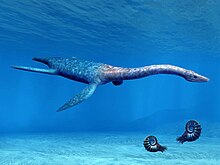| Attenborosaurus Temporal range: Early Jurassic, 196.5–189.6 Ma PreꞒ Ꞓ O S D C P T J K Pg N | |
|---|---|

| |
| Casts of the holotype specimen (NHMUK PV R 1339): one showing the left side view of the thorax (top) and another showing the underside of the body and right side view of the neck and skull (bottom), Natural History Museum | |
| Scientific classification | |
| Domain: | Eukaryota |
| Kingdom: | Animalia |
| Phylum: | Chordata |
| Class: | Reptilia |
| Superorder: | †Sauropterygia |
| Order: | †Plesiosauria |
| Family: | †Pliosauridae |
| Genus: | †Attenborosaurus Bakker, 1993 |
| Species: | †A. conybeari |
| Binomial name | |
| †Attenborosaurus conybeari (Sollas, 1881) | |
| Synonyms | |
| |
Attenborosaurus is an extinct genus of pliosaurid from the Early Jurassic of Dorset, England. The type species is A. conybeari. The genus is named after David Attenborough, the species after William Conybeare.
History

The original remains of the holotype, specimen, were discovered in Charmouth, Dorset, England in 1880 and was described in 1881. This original specimen was housed at the Bristol City Museum and Art Gallery where it stayed until it was destroyed in November 1940, during World War II. Thankfully, before the war, a cast had been made by William Johnson Sollas, c. 1888 and sent to the Natural History Museum in London. This specimen (specimen NHMUK PV R1339) is still housed at the Natural History Museum, London along with two referred specimens: specimen NHMUK OR 39514 which includes part of the skull; and specimen NHMUK OR 40140 which includes a skull and postcrania and was purchased by E.C. Day in 1866, also from Dorset. Specimens NHMUK PV R 1339 and NHMUK OR 40140 are both on public display in Fossil Way at the museum (although NHMUK OR 40140 is mislabeled as "40140/R1360").
At first the animal was thought to be another Plesiosaurus species by William Johnson Sollas in 1881, but after studies on the plaster casts made after the remains, Plesiosaurus conybeari was assigned to a new genus (Attenborosaurus) by Robert T. Bakker in 1993.
Description

Judging by the holotype, which is the partial remains of one single specimen, the length of the animal was about 4.3 m (14 ft). Much like its plesiosaur cousins, it was piscivorous. From the skin impression found with the bones, which was later destroyed, it is presumed that the creature had membranous skin, devoid of any significantly large scales, probably for decreasing water resistances.
Classification
The following cladogram follows an analysis by Benson & Druckenmiller (2014).
| Plesiosauria |
| |||||||||||||||||||||||||||||||||||||||||||||||||||||||||||||||||||||||||||||||||||||||
See also
- List of things named after David Attenborough and his works
- Timeline of plesiosaur research
- List of plesiosaur genera
References
- ^ Bakker, R. T. (1993). Plesiosaur extinction cycles - events that mark the beginning, middle and end of the Cretaceous. Geological Association of Canada, Special Paper 39:641–664
- ^ Sollas, W.J. (1881). "On a new species of Plesiosaurus (P. Conybeari) from the Lower Lias of Charmouth; with observations on P. megacephalus, Stutchbury, and P. brachycephalus, Owen" (PDF). Quarterly Journal of the Geological Society of London. 37: 440–480.
- ^ "Attenborosaurus: a celebrity reptile". nhm.ac.uk. Retrieved 10 September 2021.
- Ketchum, H. F.; Smith, A. S. (2010). "The anatomy and taxonomy of Macroplata tenuiceps (Sauropterygia, Plesiosauria) from the Hettangian (Lower Jurassic) of Warwickshire, United Kingdom" (PDF). Journal of Vertebrate Paleontology. 30 (4): 1069–1081. doi:10.1080/02724634.2010.483604. S2CID 85081282.
- Benson, R. B. J.; Druckenmiller, P. S. (2013). "Faunal turnover of marine tetrapods during the Jurassic-Cretaceous transition". Biological Reviews. 89 (1): 1–23. doi:10.1111/brv.12038. PMID 23581455. S2CID 19710180.
External links
| Taxon identifiers | |
|---|---|
| Attenborosaurus |
|






